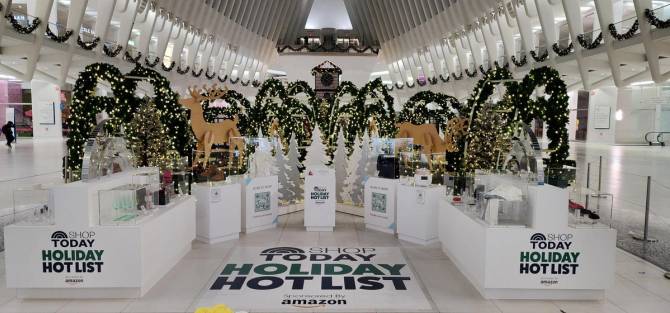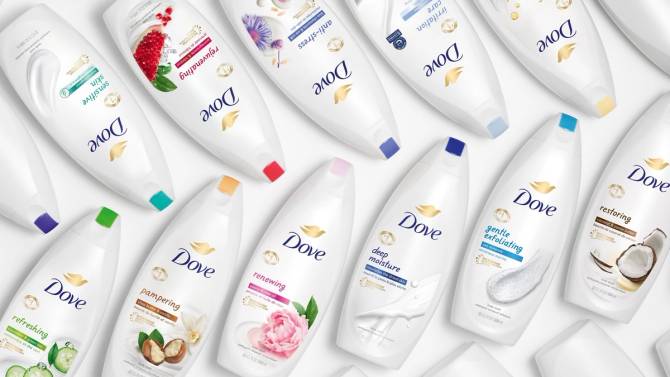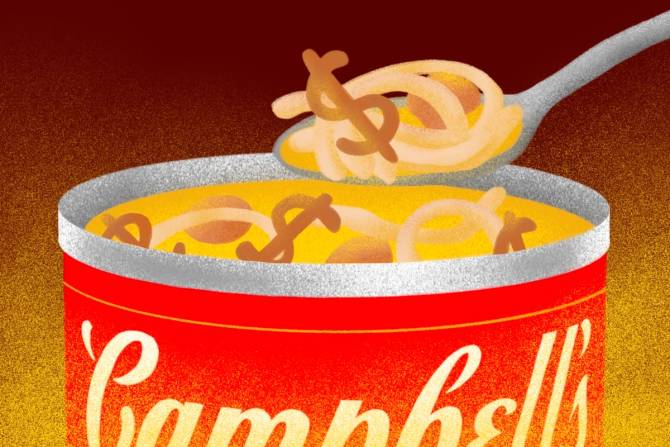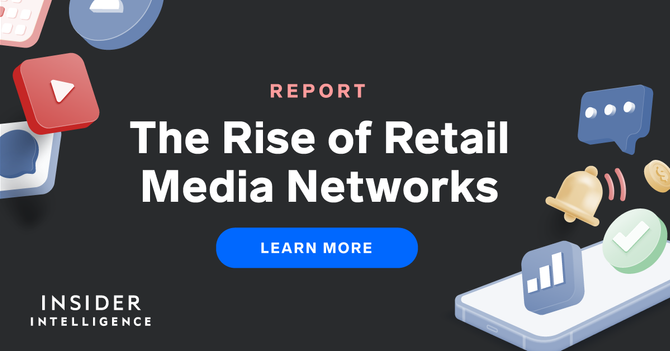Good afternoon. First, we want to take a moment to thank those who filled out our overlooked/overhyped survey. For the rest of you, we have no words…except that you still have time!
Once again, here is the link to the survey, the results of which will be used for an upcoming Retail Brew story. Your input is very much appreciated.
In today’s edition:
—Katishi Maake, Erin Cabrey, Max Knoblauch
|
|
Today
The famed Shop Today holiday gift guide is getting a makeover as an in-person shopping experience.
The commerce arm of NBC’s Today last week debuted its first pop-up space in the Shops at the Oculus at Westfield World Trade Center that is outfitted with roughly 40 of the gift guide’s products—which include slippers, tumblers, and even a personal karaoke microphone—encased in glass that shoppers can purchase by scanning a QR code and having the product shipped straight to their home.
-
The activation does not carry inventory for the sake of space, but is meant to corral tourists, visitors to the World Trade Center, and dedicated Today shoppers.
- It’s also in partnership with Amazon, and many of the products are available on the e-commerce behemoth’s website.
An in-person gallery was the “next natural iteration” for Shop Today, which has promoted content through live television broadcasts, streaming, and online since 2017, Ashley Parrish, SVP of commerce at NBC, told Retail Brew.
“We always want to make things easier for our audience, whether that is scanning a QR code or reducing the friction in between when somebody sees a product and wants to actually transact on it,” she said. “We think we’re solving a need obviously with the product curation, but also that they experienced by that use of the QR code.”
Parrish explained that an in-person pop-up was a new way to expand the brand’s reach to new customers and further tailor a product for the needs of existing consumers, which centers around three principles: meeting the audience where they are, creating an easy shopping experience, and folding the brand and experience into the day-to-day of customers who regularly watch the show.
Keep reading here.—KM
|
|
|
We all want massive budgets that generate engagement and boost sales. But your biggest customer wins sometimes come in small packages—like a downsized, small-format brick-and-mortar store.
Small-format stores support product and brand discovery, facilitating fulfillment and reverse logistics + building customer engagement and loyalty.
Placer.ai put together a white paper that analyzes exactly how going small can help you win big. Get answers to questions like:
- Which retailers open small-format stores near existing larger-format locations to serve a niche demographic?
- Why is a leading grocery company relying on small-format stores to promote a new brand experience?
- How did a legacy department store brand attract key consumer segments through its small-format concept?
Sometimes, smaller is superior. See why when you download the white paper here.
|
|
Unilever
It’s been nearly 100 years since British soapmaker Lever Brothers and Dutch margarine company Margarine Unie merged to create CPG giant Unilever, and the company has evolved a lot since then, most recently using AI to advance its product portfolio.
Alberto Prado, Unilever’s head of R&D digital and partnerships, is leading this transformation. He told Retail Brew part of his strategy is introducing digital tools to the R&D process to make innovation “better, faster, and more effective.” That means a shift from physical to digital labs, using “in silico science” (aka experiments done on the computer).
“In digital, we can plan, discover, design, and optimize in ways that we cannot in the physical space,” Prado told us. “We can do that without friction, without constraints, and without the limitations of physics and the economics around the physical world.”
Beauty secrets: Molecular models help Unilever improve its product formulas much faster than in a physical lab, cutting down the time to a few hours, Prado said. These processes are “very intimately” tied into Unilever’s sustainability goals, he noted.
- Last year, the company announced its commitment to make its products’ ingredients and formulations biodegradable by 2030. With modeling, it can simulate how a formulation will break down over 10 years rather than waiting a whole decade to find out.
Unilever has also used AI to improve its lipsticks—and save beetles. Its Hourglass Red 0 lipstick, released earlier this year, uses a vegan replacement for carmine, a commonly used lipstick pigment that requires crushing 1,000 female beetles per tube to produce, according to Prado. Unilever used modeling to determine which non-animal-derived ingredients could combine to pack the same color punch as carmine.
Keep reading here.—EC
|
|
Hannah Minn
“Campbell Soup Company is boiling hot after announcing better than expected earnings yesterday…So what’s going on with soup?” writes Morning Brew’s Max Knoblauch:
Cheap, long-lasting foods tend to do better in economic downturns. But Campbell’s didn’t find success just by waiting for inflation to hit.
Campbell’s has also upended the way its employees work, shrinking soup lab space to encourage more collaboration.
Read the whole story here on Morning Brew.
|
|
|
A seamless partnership. Thanks to Apple and Adyen, in-person contactless payments are just one click away. With Tap to Pay on iPhone, the power to seamlessly and securely accept payments through a simple tap is in your hands—no additional hardware or payment terminal needed. Get started here.
|
|
Today’s top retail reads.
Food for thought: The announcement of the Kroger-Alberston merger shook the grocery industry in October, and that’s because it’s expected to have major downstream effects that may lead to more consolidation and stiffer competition. (Supermarket News)
Feed the beast: Restaurants may take a page out of the airline industry’s playbook and start charging more for premium seating, which some think will spark consumer backlash. “You can upgrade your hotel room, your car rental, seats at a basketball game, seats on an airplane. Every other industry has figured out pricing through upgrades, except restaurants.” said Frazer Nagy, founder of Tablz. (Fast Company)
Keeping watch: Pope Francis’s Swatch—a very basic model—recently sold for over $56,000 in an auction, more than 1,000 times its retail price. The same auction featured fancier timepieces from Betty White, Condoleeza Rice, and Kenny Rogers, among others. (GQ)
Who’s #1? Signifyd ranked #1 in the Payment Security and Fraud Prevention category of the Digital Commerce 360 Leading Vendors report—for the second year in a row. Dig into the full report here.* *This is sponsored advertising content.
|
|
TOGETHER WITH INSIDER INTELLIGENCE
|
Retail media networks are growing rapidly. Our analysts review trends in retail media ad spending and provide predictions for 2023 and beyond.
Download your report now.
|
|
-
GameStop’s Q3 sales fell slightly as the chain works to expand its digital presence.
-
Express announced disappointing third-quarter results, as sales declined 8%.
-
Rebag introduced a new digital wallet feature.
-
Laura Mercier has teamed up with e-commerce platform Obsess to launch a virtual store.
-
Sephora has announced the 2023 cohort for its incubator program.
-
Amazon has been sued by the Washington D.C. attorney general’s office over withheld tips for delivery drivers.
|
|
The numbers you need to know.
Food costs are high for the average American, which now presents an opportunity for grocers to adapt to consumer expectations and deliver personalization, value, and savings that budget-conscious shoppers demand.
Almost three quarters (74%) of Americans have changed their shopping habits in the last year, with 83% now relying on some sort of coupon, rewards app, or loyalty program, according to a 1,500-person survey from tech and retail media firm Swiftly.
- Seventy percent of respondents said they prefer shopping in-person at their local grocery store.
- And 33% say they are shopping more in-store than they were in the past.
Swiftly suggests that the grocery sector is at a crossroads where the smarter players will use loyalty programs and digital coupons to drive in-store visits.
“Findings from this survey amplify the need for today’s brick-and-mortar grocers to solidify and own digital customer relationships and modernize digital revenue streams in order to be competitive and maintain a loyal customer base,” Henry Kim, Swiftly co-founder and CEO, said in a statement.
|
|
Catch up on the Retail Brew stories you may have missed.
|
|
|
Written by
Katishi Maake, Erin Cabrey, and Max Knoblauch
Was this email forwarded to you? Sign up
here.
|
ADVERTISE
//
CAREERS
//
SHOP 10% OFF
//
FAQ
Update your email preferences or unsubscribe
here.
View our privacy policy
here.
Copyright ©
2022
Morning Brew. All rights reserved.
22 W 19th St, 4th Floor, New York, NY 10011
|
|









